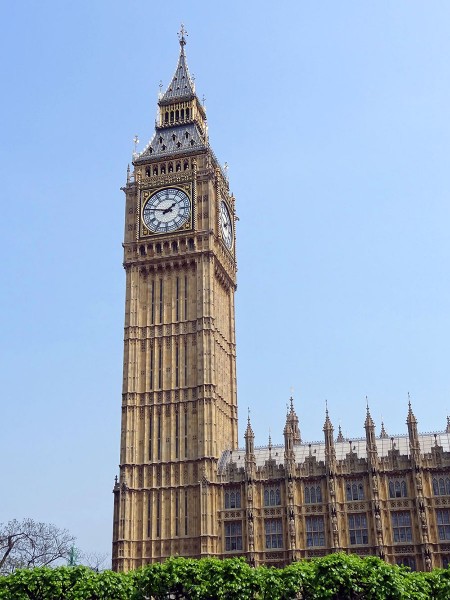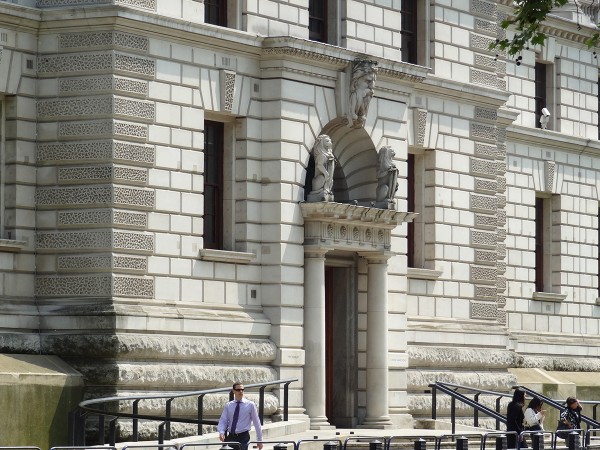 With the UK parliament in Brexit gridlock, the Labour opposition is calling for a general election. Although its policy over Brexit and a second referendum is causing splits in the party, the Labour party is generally agreed that pubic expenditure on health, education and transport infrastructure needs to increase – that there needs to be an end to fiscal austerity. However, to fund extra public expenditure would require an increase in taxes and/or an increase in government borrowing.
With the UK parliament in Brexit gridlock, the Labour opposition is calling for a general election. Although its policy over Brexit and a second referendum is causing splits in the party, the Labour party is generally agreed that pubic expenditure on health, education and transport infrastructure needs to increase – that there needs to be an end to fiscal austerity. However, to fund extra public expenditure would require an increase in taxes and/or an increase in government borrowing.
One of the arguments against increasing government borrowing is that it will increase public-sector debt. The desire to get public-sector debt down as a percentage of GDP has been central to both the Coalition and Conservative governments’ economic strategy. Austerity policies have been based on this desire.
But, in the annual presidential address to the American Economics Association, former chief economist at the IMF, Olivier Blanchard, criticised this position. He has argued for several years that cutting government deficits may weaken already weak economies and that this may significantly reduce tax revenues and potential national income, thereby harming recovery and doing long-term economic damage. Indeed, the IMF has criticised excessively tight fiscal policies for this reason.
In his presidential address, he expanded the argument to consider whether an increase in government borrowing will necessarily increase the cost of servicing government debt. When the (nominal) interest rate (r) on government borrowing is below the nominal rate of economic growth (gn), (r < gn), then even if total debt is not reduced, it is likely that the growth in tax revenues will exceed the growth in the cost of servicing the debt. Debt as a proportion of GDP will fall. The forecast nominal growth rate exceeds the 10-year nominal rate on government bonds by 1.3% in the USA, 2.2% in the UK and 1.8% in the eurozone. In fact, with the exception of a short period in the 1980s, nominal growth (gn) has typically exceeded the nominal interest rate on government borrowing (r) for decades.
When r < gn, this then gives scope for increasing government borrowing to fund additional government spending without increasing the debt/GDP ratio. Indeed, if that fiscal expansion increases both actual and potential income, then growth over time could increase, giving even more scope for public investment.
But, of course, that scope is not unlimited.
Articles
Presidential Address
Questions
- What do you understand by ‘fiscal illusion’?
- What is the justification for reducing government debt as a proportion of GDP?
- What are the arguments against reducing government debt as a proportion of GDP?
- Explain the significance of the relationship between r and gn for fiscal policy and the levels of government debt, government borrowing and the government debt/GDP ratio.
- Under what circumstances would a rise in the budget deficit not lead to a rise in government debt as a proportion of GDP?
- Does Blanchard’s analysis suggest that a combination of both loose monetary policy and loose fiscal policy is desirable?
- Under Blanchard’s analysis, what would limit the amount that governments should increase spending?
 With first Houston, then several Caribbean islands and Florida suffering dreadful flooding and destruction from Hurricanes Harvey and Irma, many are questioning whether more should be spent on flood prevention and reducing greenhouse gas emissions. Economists would normally argue that such questions are answered by conducting a cost–benefit analysis.
With first Houston, then several Caribbean islands and Florida suffering dreadful flooding and destruction from Hurricanes Harvey and Irma, many are questioning whether more should be spent on flood prevention and reducing greenhouse gas emissions. Economists would normally argue that such questions are answered by conducting a cost–benefit analysis.
However, even if the size of the costs and benefits of such policies could be measured, this would not be enough to give the answer. Whether such spending is justified would depend on the social rate of discount. But what the rate should be in cost-benefit analyses is a highly contested issue, especially when the benefits occur a long time in the future.
I you ask the question today, ‘should more have been spent on flood prevention in Houston and Miami?’, the answer would almost certainly be yes, even if the decision had to have been taken many years ago, given the time it takes to plan and construct such defences.  But if you asked people, say, 15 years ago whether such expenditure should be undertaken, many would have said no, given that the protection would be provided quite a long time in the future. Also many people back then would doubt that the defences would be necessary and many would not be planning to live there indefinitely.
But if you asked people, say, 15 years ago whether such expenditure should be undertaken, many would have said no, given that the protection would be provided quite a long time in the future. Also many people back then would doubt that the defences would be necessary and many would not be planning to live there indefinitely.
This is the familiar problem of people valuing costs and benefits in the future less than costs and benefits occurring today. To account for this, costs and benefits in the future are discounted by an annual rate to reduce them to a present value.
But with costs and benefits occurring a long time in the future, especially from measures to reduce carbon emissions, the present value is very sensitive to the rate of discount chosen. But choosing the rate of discount is fraught with difficulties.
Some argue that a social rate of discount should be similar to long-term market rates. But market rates reflect only the current generation’s private preferences. They do not reflect the costs and benefits to future generations. A social rate of discount that did take their interests into account would be much lower and could even be argued to be zero – or negative with a growing population.
Against this, however, has to be set the possibility that future generations will be richer than the current one and will therefore value a dollar (or any other currency) less than today’s generation.
 However, it is also likely, if the trend of recent decades is to continue, that economic growth will be largely confined to the rich and that the poor will be little better off, if at all. And it is the poor who often suffer the most from natural disasters. Just look, for example, at the much higher personal devastation suffered from hurricane Irma by the poor on many Caribbean islands compared with those in comparatively wealthy Florida.
However, it is also likely, if the trend of recent decades is to continue, that economic growth will be largely confined to the rich and that the poor will be little better off, if at all. And it is the poor who often suffer the most from natural disasters. Just look, for example, at the much higher personal devastation suffered from hurricane Irma by the poor on many Caribbean islands compared with those in comparatively wealthy Florida.
A low or zero discount rate would make many environmental projects socially profitable, even though they would not be with a higher rate. The choice of rate is thus crucial to the welfare of future generations who are likely to bear the brunt of climate change.
But just how should the social rate of discount be chosen? The following two articles explore the issue.
Articles
How Much Is the Future Worth? Slate, Will Oremus (1/9/17)
Climate changes the debate: The impact of demographics on long-term discount rates Vox, Eli P Fenichel, Matthew Kotchen and Ethan T Addicott (20/8/17)
Questions
- What is meant by the social rate of discount?
- Why does the choice of a lower rate of social discount imply a more aggressive climate policy?
- How is the distribution of the benefits and costs of measures to reduce carbon emissions between rich and poor relevant in choosing the social rate of discount of such measures?
- How is the distribution of the benefits of such measures between current and future generations relevant in choosing the rate?
- How is uncertainty about the magnitude of the costs and benefits relevant in choosing the rate?
- What is the difference between Stern’s and Nordhaus’ analyses of the choice of social discount rate?
- Explain and discuss the ‘mortality-based approach’ to estimating social discount rates.
- What are the arguments ‘for economists analysing climate change through the lens of minimising risk, rather than maximizing utility’?
 In a carefully argued article in the New Statesman, the UK Business Secretary, Vince Cable, considers the slow recovery in the economy and whether additional measures should be adopted. He sums up the current state of the economy as follows:
In a carefully argued article in the New Statesman, the UK Business Secretary, Vince Cable, considers the slow recovery in the economy and whether additional measures should be adopted. He sums up the current state of the economy as follows:
The British economy is still operating at levels around or below those before the 2008 financial crisis and roughly 15 per cent below an albeit unsustainable pre-crisis trend. There was next to no growth during 2012 and the prospect for 2013 is of very modest recovery.
Unsurprisingly there is vigorous debate as to what has gone wrong. And also what has gone right; unemployment has fallen as a result of a million (net) new jobs in the private sector and there is vigorous growth of new enterprises. Optimistic official growth forecasts and prophets of mass unemployment have both been confounded.
He argues that supply-side policies involving “a major and sustained commitment to skills, innovation and infrastructure investment” are essential if more rapid long-term growth is to be achieved. This is relatively uncontroversial.
 But he also considers the claim that austerity has kept the economy from recovering and whether policies to tackle the negative output gap should be adopted, even if this means a short-term increase in government borrowing.
But he also considers the claim that austerity has kept the economy from recovering and whether policies to tackle the negative output gap should be adopted, even if this means a short-term increase in government borrowing.
But crude Keynesian policies of expanding aggregate demand are both difficult to implement and may not take into account the particular circumstance of the current extended recession – or depression – in the UK and in many eurozone countries. World aggregate demand, however, is not deficient. In fact it is expanding quite rapidly, and with the sterling exchange rate index some 20% lower than before the financial crisis, this should give plenty of opportunity for UK exporters.
Yet expanding UK aggregate demand is proving difficult to achieve. Consumers, worried about falling real wages and large debts accumulated in the years of expansion, are reluctant to increase consumption and take on more debts, despite low interest rates. In the light of dampened consumer demand, firms are reluctant to invest. This makes monetary policy particularly ineffective, especially when banks have become more risk averse and wish to hold higher reserves, and indeed are under pressure to do so.
 So what can be done? He argues that there is “some scope for more demand to boost output, particularly if the stimulus is targeted on supply bottlenecks such as infrastructure and skills.” In other words, he advocates policies that will simultaneously increase both aggregate demand and aggregate supply. Monetary policy, involving negative real interest rates and quantitative easing, has helped to prevent a larger fall in real aggregate demand and a deeper dive into recession, but the dampened demand for money and the desire by banks to build their reserves has meant a massive fall in the money multiplier. Perhaps monetary policy needs to be more aggressive still (see the blog post, Doves from above), but this may not be sufficient.
So what can be done? He argues that there is “some scope for more demand to boost output, particularly if the stimulus is targeted on supply bottlenecks such as infrastructure and skills.” In other words, he advocates policies that will simultaneously increase both aggregate demand and aggregate supply. Monetary policy, involving negative real interest rates and quantitative easing, has helped to prevent a larger fall in real aggregate demand and a deeper dive into recession, but the dampened demand for money and the desire by banks to build their reserves has meant a massive fall in the money multiplier. Perhaps monetary policy needs to be more aggressive still (see the blog post, Doves from above), but this may not be sufficient.
Which brings Dr Cable to the political dynamite! He advocates an increase in public investment on infrastructure (schools and colleges, hospitals, road and rail projects and housing, and considers whether this should be financed, not by switching government expenditure away from current spending, but by borrowing more.
Such a strategy does not undermine the central objective of reducing the structural deficit, and may assist it by reviving growth. It may complicate the secondary objective of reducing government debt relative to GDP because it entails more state borrowing; but in a weak economy, more public investment increases the numerator and the denominator.
 He raises the question of whether the balance of risks has changed: away from the risk of increased short-term borrowing causing a collapse of confidence to the risk of lack of growth causing a deterioration in public finances and this causing a fall in confidence. As we saw in the blog post Moody Blues, the lack of growth has already caused one ratings agency (Moody’s) to downgrade the UK’s credit rating. The other two major agencies, Standard & Poor’s and Fitch may well follow suit.
He raises the question of whether the balance of risks has changed: away from the risk of increased short-term borrowing causing a collapse of confidence to the risk of lack of growth causing a deterioration in public finances and this causing a fall in confidence. As we saw in the blog post Moody Blues, the lack of growth has already caused one ratings agency (Moody’s) to downgrade the UK’s credit rating. The other two major agencies, Standard & Poor’s and Fitch may well follow suit.
The day after Dr Cable’s article was published, David Cameron gave a speech saying that the government would stick to its plan of deficit reduction. Not surprisingly commentators interpreted this as a split in the Coalition. Carefully argued economics from Dr Cable it might have been, but political analysts have seen it as a hand grenade, as you will see from some of the articles below.
When the facts change, should I change my mind? New Statesman, Vince Cable (6/3/13)
Keynes would be on our side New Statesman, Vince Cable (12/1/11)
Exclusive: Vince Cable calls on Osborne to change direction New Statesman, George Eaton (67/3/13)
Vince Cable: Borrowing may not be as bad as slow growth BBC News (7/3/13)
Vince Cable makes direct challenge to Cameron over economic programme The Guardian, Nicholas Watt (7/3/13)
Vince Cable Says George Osborne Must Change Course And Borrow More To Revive Growth Huffington Post, Ned Simons (6/3/13)
David Cameron and Vince Cable at war over route to recovery Independent, Andrew Grice (6/3/13)
 Vince Cable: Borrowing may not be as bad as slow growth BBC News, James Landale (6/3/13)
Vince Cable: Borrowing may not be as bad as slow growth BBC News, James Landale (6/3/13)
David Cameron: We will hold firm on economy BBC News (7/3/13)
 David Cameron: We will hold firm on economy BBC News (7/3/13)
David Cameron: We will hold firm on economy BBC News (7/3/13)
 Clegg Backs Cable Over Controversial Economy Comments LBC Radio, Nick Clegg (7/3/13)
Clegg Backs Cable Over Controversial Economy Comments LBC Radio, Nick Clegg (7/3/13)
It’s plain what George Osborne needs to do – so just get on and do it The Telegraph, Jeremy Warner (6/3/13)
Vince Cable’s plan B: a “matter of judgement” BBC News, Stephanie Flanders (7/3/13)
George Osborne needs to turn on the spending taps The Guardian, Phillip Inman (12/3/13)
Questions
- Why has monetary policy proved ineffective in achieving a rapid recovery from recession?
- Distinguish between discretionary fiscal policy and automatic fiscal stabilisers.
- Why has the existence of automatic fiscal stabilisers meant that the public-sector deficit has been difficult to bring down?
- In what ways has the balance of risks in using discretionary fiscal policy changed over the past three years?
- In what ways is the depression of the late 2000s/early 2010s (a) similar to and (b) different from the Great Depression of the early 1930s?
- In what ways is the structure of public-sector debt in the UK different from that in many countries in the eurozone? Why does this give the government more scope for expansionary fiscal policy?
- Why does the Office of Budget Responsibility’s estimates of the tax and government expenditure multipliers suggest that “if fiscal policy is to work in a Keynesian manner, it needs to be targeted carefully, concentrating on capital projects”?
- Why did Keynes argue that monetary policy is ineffective at the zero bound (to use Dr Cable’s terminology)? Are we currently at the zero bound? If so what can be done?
- Has fiscal tightening more than offset loose monetary policy?
 With the UK parliament in Brexit gridlock, the Labour opposition is calling for a general election. Although its policy over Brexit and a second referendum is causing splits in the party, the Labour party is generally agreed that pubic expenditure on health, education and transport infrastructure needs to increase – that there needs to be an end to fiscal austerity. However, to fund extra public expenditure would require an increase in taxes and/or an increase in government borrowing.
With the UK parliament in Brexit gridlock, the Labour opposition is calling for a general election. Although its policy over Brexit and a second referendum is causing splits in the party, the Labour party is generally agreed that pubic expenditure on health, education and transport infrastructure needs to increase – that there needs to be an end to fiscal austerity. However, to fund extra public expenditure would require an increase in taxes and/or an increase in government borrowing. Presidential Address: Public Debt and Low Interest Rates
Presidential Address: Public Debt and Low Interest Rates





